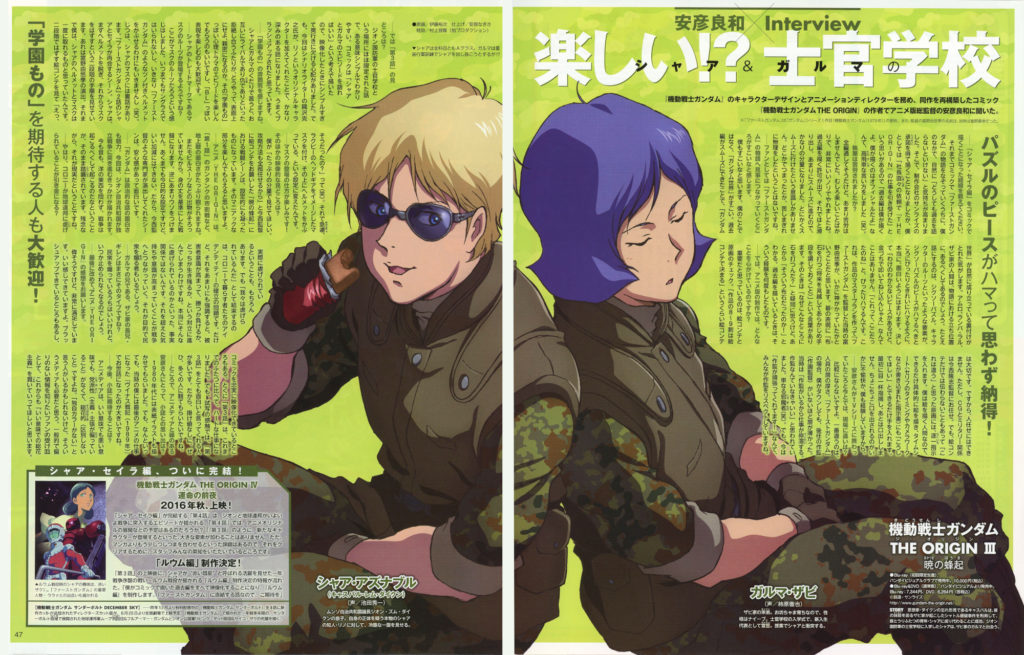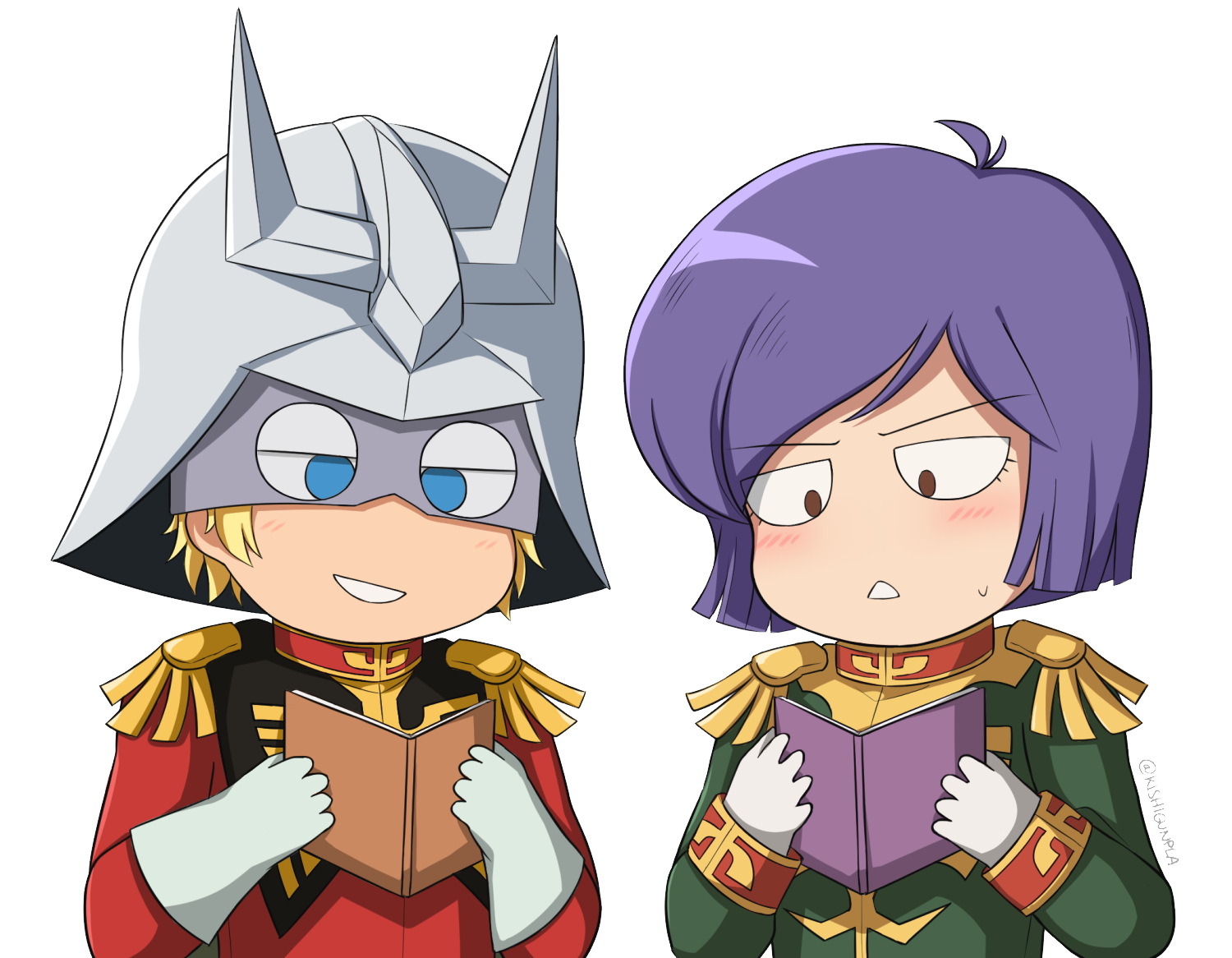
[originally posted 27 September 2023]
The following is a translation of an interview with Yoshikazu Yasuhiko, creator of the Mobile Suit Gundam: The Origin manga and director of the OVA and TV series, published in the July 2016 issue of Animedia.
The letter “Q” denotes the interviewers questions, and “Y” is Yas’s responses. The term First Gundam refers to the original Gundam anime series from 1979.
We interviewed Yoshikazu Yasuhiko, who worked as a character designer and animation director of Mobile Suit Gundam, the creator of the comic Mobile Suit Gundam: THE ORIGIN, which reconstructed the same work, and the general director of the animation version.
Q: Please tell us how you came to draw the “Char and Sayla Arc” of the comic.
Y: Up until that point in the comic, as I followed the story of First Gundam, the feeling naturally arose that “I must tell the story of their past”. And so, I received permission from the production company Sunrise and started drawing, and since the president asked me directly to work on THE ORIGIN, I said in a high-handed way, “I’ll draw the flashback chapters. What I draw is official.” (laughs)
Q: Did you have a hard time writing it?
Y: I didn’t have that much trouble the whole way through. Actually, it was a lot of fun, and I was able to do it at a very good pace. As soon as I received permission to draw the flashback chapters, things went very smoothly once I began, and it became quite voluminous. Anyway, the only thing I remember is how smoothly it went. It’s not like I was forced into it or did it out of desperation.
Q: As a fan, I think it’s amazing how it connects to the story of First Gundam.
Y: I think it’s amazing too. It’s not me, but the “Gundam world” that is amazing. The flashback chapters went smoothly because they were naturally supported by and built upon the “Gundam world”. Amuro, Ramba Ral, and the people of the Zabi family are in the positions they are supposed to be in the story. It’s like a jigsaw puzzle. Elements like the characters’ backstories fit together in really interesting ways, like how the jigsaw pieces fit neatly where they should. I never say, “There’s a piece that doesn’t make sense, so just hit it with a hammer and jam it in.” Instead I say, “This goes here, right?” and it fits perfectly. I think this is how godly Yoshiyuki Tomino was at the time when he made the master plan for the work and directed First Gundam.
In the game of Go, there is a phrase, “to prepare your opening position (to anticipate the future and take measures in advance)”. At that time, I wondered, “Why did you put a stone in such a place?” But then I later understood, “I see, it was that kind of opening!” When I was drawing the flashback chapters, I had that kind of experience many times.
Q: So, what kind of things did you keep in mind when producing the anime version?
Y: I think it’s important to check the storyboards and original drawings. “80% to 90% of the work is decided by storyboards”. That’s how important storyboards are. Therefore, it cannot be left up to others. However, I will leave the CG and military affairs to Director Takashi Imanishi. Moreover, there are some things that can’t be conveyed through storyboards alone, so if I think “this is wrong”, I will give detailed instructions. I’m a person who draws pictures, so I draw with as much attention to detail as possible, and make as many changes as possible to the timesheet (instructions written with the timing of the dialogue and camera work). I will point things out as much as possible at the beginning, and then I will not intervene. I know how unpleasant it can be to have someone constantly interrupting.
Q: Yasuhiko-san, what are the differences between when you were working on the TV series (First Gundam) and now?
Y: It’s not comparable. The biggest difference is the bench strength of the staff. In the case of First Gundam, even if I went down, the bench was so weak that there was no backup animation director. At that time it was thought, “Work slows down because there is an animation director. Who needs an animation director.” Just a nuisance (laughs). But now, everyone respects the animation director, saying, “The animation director is doing his best!”
Q: Then, what is the highlight of “Episode 3”?
Y: The story is mostly limited to the location of the Zeon Defense Forces military academy, and in a sense it is simple and easy to understand. I drew the comic with the idea that “it would be good to talk about the story of Char and Garma”, so I was worried that it would be too simple and lack depth when it was animated. But this time, scenario writer Katsuyuki Sumisawa added an original character named Lino, which made the story much deeper. I think it was brushed up nicely.
Q: You can feel the atmosphere of the “school theme”.
Y: In the story of Char and Garma, how do two people who reject each other as rivals and enemies become closer, more than just on the surface? You could enjoy it as a “school themed” psychological drama episode, and you’re also very welcome to enjoy it as a “BL”-like expression.
Q: It seems that the roots of Char’s trademark mask will appear?
Y: I felt that the root of the mask would be here. He can’t wear sunglasses forever, and he can’t suddenly put on a horned helmet like in First Gundam (laughs). In fact, Char’s mask has a story behind it. In the scene where Char and Sayla meet again in Episode 2 of First Gundam, Char shows a two-step process of first removing the helmet and then removing the mask. That was orchestrated by Yoshiyuki Tomino. Until then, I had thought that Char’s helmet and mask could be taken off all at once. When I saw in the storyboards that they were removed in two stages, I thought, “Oh, was that so?” (laughs). That’s why I quickly changed the design to be a mask that looks like rugby headgear with a helmet on top of it.
Q: I’m looking forward to seeing how the mask will appear! What are some other visual highlights?
Y: I asked Director Imanishi for the storyboards, saying, “I want you to show us a lot. I leave the methodology to you”, and so the battle scenes in Dawn of Rebellion became elaborate even from a design standpoint. I think that you will enjoy those nerdy details.
Q: In THE ORIGIN anime, you can see a lot of interesting ground battles, such as the Guntank street battle in “Episode 1”.
Y: Mobile suits aren’t ready to be featured just yet, so battles are based on stature. Conversely, we can’t just make things up. It’s a modern setting, but we can’t do it sloppily. That’s why the scenes directed by an expert like Director Imanishi are reassuring and interesting.
Q: Gundam is also attractive for its political story. This time, the trigger for the Autonomous Republic of Zeon to rush into the war of independence is depicted.
Y: No matter when or where, the idea that war will occur wherever it can will be followed through. Unfortunately, that is the reality.
Q: After all, the trigger is that the colony is oppressed by the Earth Federation?
Y: Of course, there is also the fact that they are actually being oppressed. However, it is the matter of establishing the identity of those who live in the colony that unites them under “we are being oppressed.” Even so, if emphasized too much, a state of victimhood will arise, and it will lead to a confrontation where you will win or lose, survive or perish. It doesn’t matter whether they are really oppressed or not. The heightening of feelings and awareness beyond that will lead to war. There will be those who incite the public for that purpose.
Q: Garma’s older brother Gihren, the eldest brother of the Zabi family, is exactly that type, isn’t he?
Y: It’s fine as long as it’s just inciting the people, but someday it won’t be able to be stopped.
Q: Lastly, please give us your impressions of the anime THE ORIGIN.
Y: Not to speak highly of myself, but I’m extremely satisfied with it. I feel good about it. We were able to touch up a few areas, and there are places where we have faithfully visualized the comic. In particular, “Episode 3” was a more difficult job compared to the previous two. However, in test screenings, many people said that “Episode 3” was very interesting. And so, with no exaggeration, I definitely want many people to see it.
Q: By the way, Yasuhiko-san, since you have a connection with Animedia, what are your memories of our magazine?
Y: In the 1980s, I was also asked to draw a cover illustration. But more than anything, I was greatly helped during Venus Wars (1989) which was the latest animation work for me at that time.
Q: What do you expect from the magazine in the future?
Y: Whether in a good or bad sense, Animedia has no partisanship (in terms of biased principles or claims) and is all-round (doesn’t distinguish). There may be people out there who say it has no uniqueness, but I think that kind of media is also necessary, and I would like you to continue to stick to “pleasing everyone with good intentions”, and as a receptacle for fans who want to know general and unbiased information.
